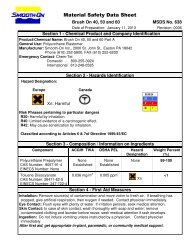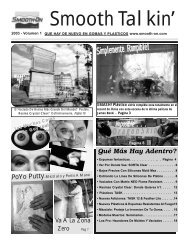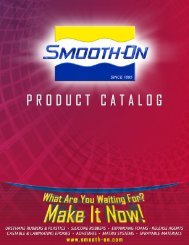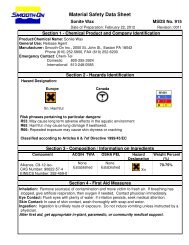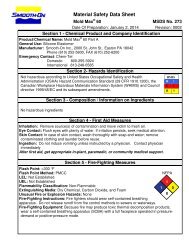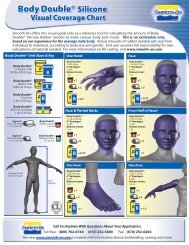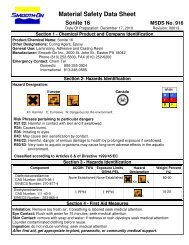MSDS - Smooth-On, Inc.
MSDS - Smooth-On, Inc.
MSDS - Smooth-On, Inc.
You also want an ePaper? Increase the reach of your titles
YUMPU automatically turns print PDFs into web optimized ePapers that Google loves.
<strong>MSDS</strong> No. 618 Vytaflex Series Revision: 0007Section 5 - Fire-Fighting MeasuresFlash Point: >270 °F (132°C)NFPAFlash Point Method: TOCLEL: Not Established1UEL: Not EstablishedFlammability Classification: Non-Flammable2 1Extinguishing Media: Water Fog, Dry Chemical, Carbon Dioxide Foam0Unusual Fire or Explosion Hazards: Hazardous decomposition products maybe formed. Avoid water contamination in closed containers or confined areas asexothermic heat and carbon dioxide can evolve.Fire-Fighting Instructions: Fire fighters should wear self contained breathing apparatus. Donot release runoff from fire control methods to sewers or waterways.Fire-Fighting Equipment: Because fire may produce toxic thermal decomposition products,wear a self-contained breathing apparatus (SCBA) with a full face piece operated in pressuredemandor positive-pressure mode.Section 6 - Accidental Release MeasuresSpill /Leak Procedures: <strong>On</strong>ly properly protected personnel should remain in the spill area; dikeand contain spill; absorb or scrape up excess into suitable container for disposal; wash area withdilute ammonia solution. Stop or reduce discharge if it can be done safely.Section 7 - Handling and StorageHandling Precautions: Minimize breathing of vapors and avoid prolonged or repeated contactwith skin. Wear proper protective equipment. If ventilation is not sufficient, wear properrespiratory equipment. Avoid moisture contamination. Reseal partial containers. Use goodgeneral housekeeping procedures.Storage Requirements: Store in cool dry, well-ventilated area.Section 8 - Exposure Controls / Personal ProtectionRespiratory Protection: Follow OSHA respirator regulations 29 CFR 1910.134 and EuropeanStandards EN 141, 143 and 371; wear an MSHA/NIOSH or European Standards EN 141, 143and 371 approved respirators. Warning! Air-purifying respirators do not protect workers inoxygen-deficient atmospheres. If respirators are used, OSHA requires a written respiratoryprotection program that includes at least: medical certification, training, fit-testing, periodicenvironmental monitoring, maintenance, inspection, cleaning, and convenient, sanitary storageareas.Protective Clothing/Equipment: Wear chemically protective gloves, boots, and aprons toprevent prolonged or repeated skin contact. Wear protective eyeglasses or chemical safetygoggles, per OSHA eye- and face-protection regulations 29 CFR 1910.133 and EuropeanStandard EN166. Contact lenses are not eye protective devices. Appropriate eye protectionmust be worn instead of, or in conjunction with contact lenses.Comments: Never eat, drink, or smoke in work areas. Practice good personal hygiene afterusing this material, especially before eating, drinking, smoking, using the toilet, or applyingcosmeticsPage 2



